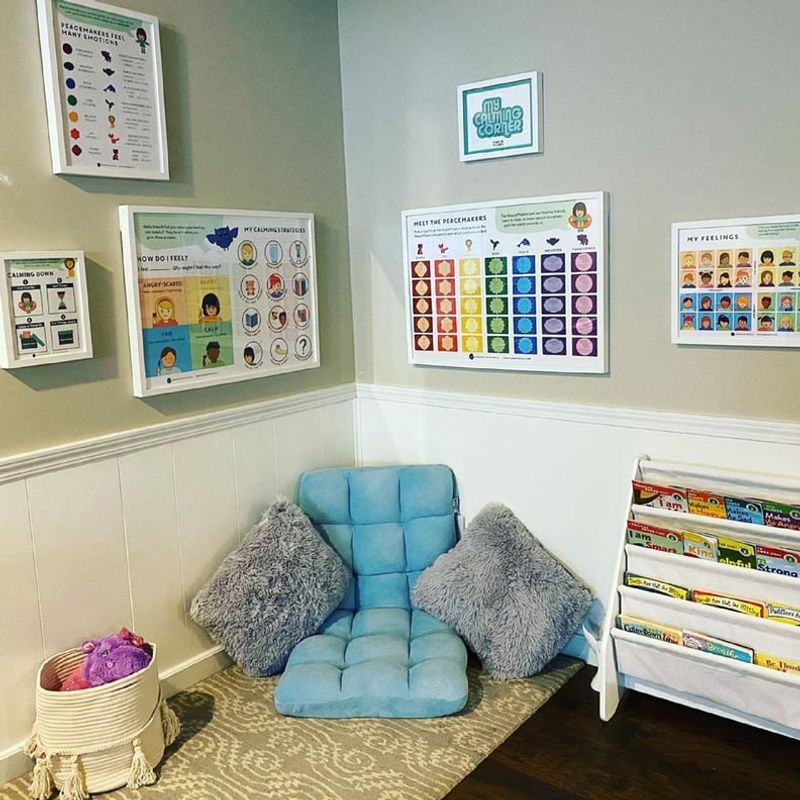Raising emotionally savvy kids requires a thoughtful approach, where parents model and teach emotional intelligence through everyday actions. Children learn not only from what they are directly taught but also by observing and emulating their parents’ behavior.
This guide explores 20 key behaviors that parents can adopt to nurture emotional awareness and resilience in their children.
1. Validate their feelings without judgment
When a child feels heard, they flourish. Acknowledging their emotions without immediate correction or dismissal builds trust. Taking a moment to genuinely connect, like kneeling to their level, shows respect and empathy.
This simple act can profoundly impact a child’s sense of safety. It teaches them that their emotions are valid, fostering confidence. Rather than rushing to solutions, let the child express freely. This cultivates a nurturing environment where they feel valued. It’s here that emotional intelligence starts to bloom.
2. Model calm communication during conflict
Peaceful conflict resolution is a cornerstone of emotional maturity. When parents maintain composure during disputes, they demonstrate strength. Children witness this, learning the power of calm words. By using gentle tones and expressing needs clearly, parents model effective communication strategies.
This teaches children the art of dialogue. In everyday disagreements, staying composed becomes a lesson in itself. The dining table can transform into a classroom where emotional skills are taught. It’s in these moments that children learn to navigate conflicts gracefully.
3. Label emotions openly and accurately
Identifying emotions is a fundamental skill in emotional intelligence. When parents name their feelings, they help children build an emotional vocabulary. Using tools like emotion charts can make this process engaging and educational.
It’s about showing that it’s okay to feel a spectrum of emotions. This practice normalizes emotional expression and encourages kids to articulate their own feelings. As children grow, they learn to recognize emotions in themselves and others. Such awareness is the first step towards empathy.
4. Show it’s okay to apologize
Apologies are powerful in repairing bonds. When parents model genuine remorse, they teach humility and responsibility. It reassures children that mistakes are part of being human. Offering a heartfelt apology, perhaps after a misunderstanding, reinforces trust.
It’s in these moments that children learn the value of honesty and integrity. By witnessing this, they understand that relationships can be mended with sincerity. This lesson in accountability is invaluable as they navigate their own social interactions.
5. Teach coping strategies, not suppression
Coping mechanisms are vital for emotional resilience. Instead of suppressing feelings, children need tools to manage them. Parents can introduce strategies like deep breathing or mindful pauses. These techniques provide a healthy outlet for stress and frustration.
Practicing in serene environments, such as a garden, enhances the experience. It’s about empowering children to handle emotions constructively. This nurturing approach helps them develop lifelong skills for emotional well-being.
6. Ask questions instead of making assumptions
Inquiry opens doors to understanding. By asking rather than assuming, parents gain insights into their child’s world. This approach encourages open communication and self-expression. It shows the child their voice matters, fostering confidence and trust.
A simple conversation on a park bench can reveal layers of emotions and thoughts. It’s a practice that strengthens the parent-child bond, ensuring children feel valued and understood. This habit develops a foundation for empathy and connection.
7. Encourage emotional honesty
Honesty in expressing emotions builds authenticity. When parents encourage open dialogue, children learn to trust their feelings. Sharing personal experiences and listening without judgment creates a safe space. It’s important to validate all emotions, even the challenging ones.
This practice fosters a home environment where children feel free to be themselves. Over time, they develop a genuine understanding of their own emotions and those of others. Emotional honesty strengthens family ties and prepares children for future relationships.
8. Praise effort, not perfection
Effort is the true measure of growth. Celebrating perseverance over perfection boosts a child’s self-esteem. Parents who acknowledge hard work teach resilience and persistence. A simple act of praise for a drawing encourages creativity and determination.
It’s crucial that children understand growth comes from trying and learning. This approach motivates them to embrace challenges with enthusiasm. By valuing effort, parents nurture a mindset geared towards lifelong learning.
9. Let kids see you process hard days
Life’s challenges are opportunities for learning. When parents show their children how they handle tough days, they provide a powerful lesson in resilience. It’s about being transparent with emotions without burdening the child. Reflecting openly, perhaps over a cup of tea, illustrates coping in action.
This demonstrates that it’s okay to have difficult times and that they can be managed. Children learn that perseverance and adaptability are key to navigating life’s ups and downs.
10. Don’t fix everything—listen instead
Listening is sometimes all it takes to heal. Parents often rush to solve problems, but sometimes, being present is enough. By offering an attentive ear, they show empathy and respect for their child’s experiences. This practice encourages children to express themselves and explore solutions independently.
It’s about valuing their words and emotions, which builds trust and confidence. Through listening, parents teach children that they are supported and understood, fostering emotional growth.
11. Share your own growth mindset
A growth mindset transforms challenges into stepping stones. When parents share their experiences of overcoming obstacles, they inspire resilience. By talking about personal growth during a walk, children connect everyday activities with learning.
This encourages them to view setbacks as opportunities for improvement. Understanding that growth is a continuous journey helps children face challenges with optimism. It’s a lesson in adaptability and lifelong learning, essential for emotional development.
12. Teach boundaries through your actions
Boundaries are vital for healthy relationships. When parents demonstrate respect for personal space and limits, children learn to do the same. Setting and respecting boundaries in everyday situations, like at a playground, reinforces this lesson.
It’s about clear communication and understanding mutual respect. Children observe and internalize these actions, which helps them develop their own boundaries. This practice fosters self-respect and empathy, essential components of emotional intelligence.
13. Stay consistent with consequences
Consistency builds trust and security. When parents follow through with consequences, they teach reliability and fairness. This approach helps children understand the link between actions and outcomes. Explaining consequences calmly, perhaps using a chart, reinforces this concept.
It’s about creating a structured environment where children feel safe and understood. Consistency in parenting provides a framework for children to learn accountability and responsibility.
14. Allow kids space to cool off
Space can be the best remedy for heightened emotions. Allowing children to step back and regroup teaches self-regulation. It’s about recognizing when emotions are too big and taking a break. A designated calm space, like a playroom corner, provides a refuge.
This practice encourages children to manage their emotions independently. It’s a lesson in self-care and emotional awareness, crucial for personal growth. Learning to pause and reflect fosters resilience and composure.
15. Normalize big emotions—don’t shame them
Big emotions are part of human experience. Acknowledging them without shame teaches acceptance. When a child cries, comforting them amidst nature can be soothing. It’s about making emotions relatable and manageable.
By normalizing emotional expression, parents help children embrace their feelings without fear. This nurturing approach builds emotional resilience and confidence. Understanding that emotions are natural and acceptable is key to emotional well-being.
16. Teach the power of a pause before reacting
Pausing before reacting is a powerful tool in emotional management. Teaching mindfulness techniques, like meditation, strengthens this skill. Practicing together in a calm setting, such as a living room, reinforces patience. It’s about taking a moment to breathe and reflect before responding.
This approach helps children develop control over their reactions and fosters mindfulness. It’s an essential lesson in self-awareness, enhancing emotional and mental balance.
17. Include them in age-appropriate problem solving
Problem-solving skills are nurtured through collaboration. Including children in discussions about age-appropriate issues fosters their ability to think critically. Working on puzzles or small tasks at a kitchen table illustrates teamwork. It’s about guiding them to solutions without taking over.
This practice boosts their confidence and decision-making abilities. By involving them, parents show trust in their capabilities, encouraging growth and independence.
18. Explain your feelings when you’re calm
Self-expression enriches understanding. When parents articulate their emotions calmly, they demonstrate emotional literacy. Sharing feelings during quiet moments, like on a sofa, encourages open dialogue. It’s about being transparent without overwhelming the child.
This practice nurtures empathy and trust, allowing children to feel safe in expressing themselves. Understanding parental emotions aids in developing strong emotional bonds.
19. Hold space without rushing them through emotions
Patience is a profound gift. Holding space means allowing children to explore their emotions at their own pace. Sitting quietly beside them, perhaps in a garden, creates a comforting environment. This practice shows respect for their emotional journey.
It’s about letting them process feelings without pressure or judgment. By doing so, parents teach acceptance and understanding, fostering emotional growth and resilience.
20. Prioritize connection over control
Connection is the heart of healthy relationships. When parents choose to connect rather than control, they build trust and joy. Engaging in playful activities fosters a deep emotional bond. It’s about being present and valuing time together.
This nurturing approach encourages mutual respect and understanding. Prioritizing connections leads to a harmonious family dynamic, where children feel loved and secure.





















